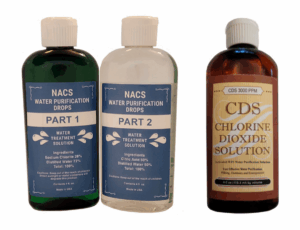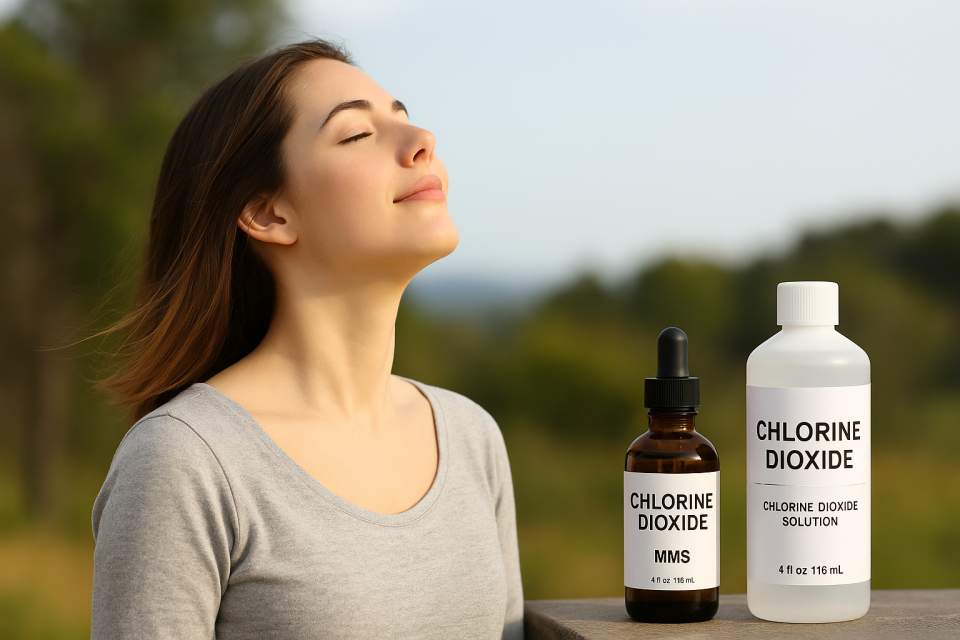Respiratory disorders are among the most debilitating health challenges worldwide, affecting millions of people with symptoms like shortness of breath, coughing, fatigue, and loss of vitality. Whether the cause is viral, bacterial, environmental, or autoimmune, these disorders share a common thread: inflammation and oxidative damage within the lungs.
Chlorine dioxide (ClO₂), known primarily as a water purifier, has gained increasing attention in the natural health community for its broad-spectrum antimicrobial and oxygenating properties. As a selective oxidizer, it targets pathogens and damaged cells while leaving healthy tissue unharmed. When used carefully and responsibly, many people report significant relief from chronic and acute respiratory issues.
Below is an overview of the most commonly reported respiratory maladies, how chlorine dioxide appears to help, and the general non-medical methods used by individuals in the field.
- Asthma
Cause:
Asthma is a chronic inflammatory condition in which the airways narrow and swell, producing excess mucus. Triggers include allergens, pollution, stress, and infection.
Symptoms:
Wheezing, coughing, chest tightness, and shortness of breath, particularly at night or after exertion.
How Chlorine Dioxide Helps:
Reports suggest chlorine dioxide reduces airway inflammation by neutralizing microbial overgrowth and toxic residues that trigger immune reactions. It may also aid in oxygenation of blood, improving lung efficiency.
Suggested Use (As Reported by Others):
Many users start with low oral doses following Jim Humble’s Protocol 1000, which involves combining oral intake with chlorine dioxide inhalation through indirect vapor (not direct breathing of the gas) in a closed container or via a humidifier method, all under the guidance of non-medical protocols.
- Chronic Obstructive Pulmonary Disease (COPD)
Cause:
Long-term exposure to irritants, most often cigarette smoke, leading to lung tissue destruction and airway blockage.
Symptoms:
Chronic cough, mucus production, shortness of breath, fatigue, and frequent infections.
How Chlorine Dioxide Helps:
Chlorine dioxide’s mild oxidative action can assist in reducing the microbial load in the lungs and break down biofilms—protective layers of bacteria that worsen COPD flare-ups. Reports suggest improved breathing and fewer infections with consistent low-dose oral intake and topical chest applications.
- COVID-19 and Other Viral Infections
Cause:
Viral infection (commonly SARS-CoV-2) affects the upper and lower respiratory tract, leading to severe inflammation and clotting in advanced cases.
Symptoms:
Fever, cough, fatigue, loss of smell/taste, difficulty breathing, and, in some cases, respiratory failure.
How Chlorine Dioxide Helps:
In numerous anecdotal reports and studies from Latin America (notably Bolivia and Mexico), chlorine dioxide was used under compassionate-use authorization to reduce viral load and inflammation. Users often report restored oxygen saturation, reduced fever, and shorter recovery time.
Suggested Use:
Protocol 1000 and CDS (chlorine dioxide solution) diluted in water throughout the day are common. Topical sprays and vapor exposure (never inhaling concentrated gas) are also reported to help open airways.
- Bronchitis
Cause:
Infection or irritation causes inflammation of the bronchial tubes. Can be viral, bacterial, or due to pollutants.
Symptoms:
Persistent cough producing mucus, chest discomfort, fatigue, mild fever, and shortness of breath.
How Chlorine Dioxide Helps:
Acts as an antimicrobial and mucolytic, helping dissolve mucus and neutralize bacteria or viruses. It can also reduce inflammation in the bronchial linings.
- Emphysema
Cause:
A component of COPD where the alveoli (air sacs) are damaged, reducing oxygen exchange. Most often caused by smoking or toxic inhalation exposure.
Symptoms:
Progressive shortness of breath, barrel chest, fatigue, cyanosis (bluish skin), and chronic cough.
How Chlorine Dioxide Helps:
May assist in improving oxygen utilization and reducing residual infection. It has been reported to help clear mucus and promote more efficient breathing through detoxification of the alveoli environment.
- Pneumonia
Cause:
Bacterial, viral, or fungal infection leading to inflammation of the air sacs, which may fill with pus or fluid.
Symptoms:
High fever, chills, cough with phlegm, rapid breathing, and chest pain.
How Chlorine Dioxide Helps:
Acts as a pathogen oxidizer, attacking bacterial membranes and viral envelopes. It supports faster recovery when used with rest and hydration. Users report rapid fever reduction and improved breathing within days of starting chlorine dioxide protocols.
- Pulmonary Fibrosis
Cause:
Scarring and stiffening of lung tissue from toxins, infections, autoimmune conditions, or unknown causes.
Symptoms:
Chronic dry cough, shortness of breath, fatigue, and clubbed fingers.
How Chlorine Dioxide Helps:
Its oxidative action may reduce inflammation and microbial presence, contributing to fibrosis progression. Long-term users have reported increased oxygen levels and mobility, though fibrosis reversal is rarely claimed.
- Lung Cancer
Cause:
Uncontrolled cell growth in lung tissue, often linked to smoking, pollutants, or genetic factors.
Symptoms:
Chronic cough, weight loss, chest pain, blood in sputum, and fatigue.
How Chlorine Dioxide Helps:
Because chlorine dioxide oxidizes abnormal cells with high acidity and low oxygen content, it may selectively disrupt cancer cell metabolism. While not a cure, users report slowed tumor progression and improved comfort when combined with holistic treatments and detox support.
- Cystic Fibrosis
Cause:
Genetic disorder causing thick mucus buildup in lungs and digestive system.
Symptoms:
Persistent cough, frequent lung infections, poor growth, and difficulty breathing.
How Chlorine Dioxide Helps:
Reported to help reduce infection frequency by breaking down mucus biofilms and neutralizing bacteria like Pseudomonas aeruginosa. Oral use and nebulized diluted solutions under practitioner oversight have been reported by families seeking relief.
- Pulmonary Embolism
Cause:
A blood clot (usually from the legs) travels to the lungs, blocking blood flow.
Symptoms:
Sudden shortness of breath, chest pain, coughing blood, and dizziness.
How Chlorine Dioxide Helps:
Indirectly assists by improving blood oxygenation and red cell efficiency, though not a substitute for emergency care. Long-term use may reduce clot-related inflammation and help prevent recurrent respiratory distress.
- Sarcoidosis
Cause:
An inflammatory disease where clusters of immune cells form granulomas in the lungs or lymph nodes.
Symptoms:
Shortness of breath, persistent dry cough, fatigue, and skin or eye inflammation.
How Chlorine Dioxide Helps:
Reports suggest that its gentle oxidative process may assist in immune modulation and breaking down inflammatory clusters, providing relief from chronic inflammation.
- Bronchiectasis
Cause:
Chronic condition where bronchial walls are damaged, causing mucus buildup and bacterial infection.
Symptoms:
Chronic productive cough, fatigue, breathlessness, and recurrent lung infections.
How Chlorine Dioxide Helps:
By oxidizing trapped pathogens and breaking down mucus, chlorine dioxide may help restore cleaner airway function and reduce bacterial colonization.
How Chlorine Dioxide Works
Chlorine dioxide is a selective oxidizer; it targets harmful pathogens, diseased cells, and toxins by drawing away electrons from molecules that are acidic or diseased. Healthy cells, which have balanced pH and electrical potential, are left intact. This allows it to reduce microbial load while improving oxygen delivery and cellular detoxification throughout the body.
Its reported effects include:
-
- Reduction of microbial infection (bacteria, fungi, viruses, and parasites)
- Improved oxygen transport
- Lower inflammation
- Detoxification of heavy metals and biofilms
- Enhanced immune balance

How to Use Chlorine Dioxide for Respiratory Conditions
The following non-medical methods have been reported by users and documented in the works of Jim Humble, Andreas Kalcker, and numerous field practitioners:
| Method | Description |
| Protocol 1000 | Oral ingestion of 3 drops of activated chlorine dioxide (MMS) in 100 mL of water, taken hourly for 8 hours daily for 21 days. |
| CDS Solution (Chlorine Dioxide Solution) | A gas-infused water (0.3% solution) sipped slowly throughout the day, diluted to approximately 10–20 ppm per glass. |
| Topical/Vapor Application | Some use light vapor exposure (bowl of warm water with a few drops nearby) for indirect inhalation, avoiding direct breathing of concentrated gas. |
| Nebulization (Advanced) | Under supervision, significantly diluted CDS (1 drop per 200 mL saline) has been used in some countries for lung disinfection. |
| Rectal or Transdermal Routes | Occasionally reported for systemic oxygenation when oral intake is not tolerated. Topical use commonly mixes diluted chlorine dioxide with DMSO, which is applied by rubbing it into the skin surrounding the affected area for a few minutes. |
(Note: These uses are based on field reports and not FDA-approved medical practices.)
Supporting Information
-
- A 2010 EPA report recognizes chlorine dioxide as a potent antimicrobial effective against bacteria, fungi, and viruses at concentrations safe for potable water.
- Studies in Bolivia (2020–2021) during the COVID-19 pandemic reported significant improvement in oxygen levels and symptom reduction in patients treated with chlorine dioxide solution under medical supervision.
- Laboratory tests confirm its virucidal and bactericidal properties without producing harmful chlorinated byproducts.
While mainstream medicine continues to debate the role of chlorine dioxide, growing evidence and thousands of personal testimonials suggest that this simple molecule may hold immense potential in restoring lung health, combating chronic infections, and oxygenating damaged tissue.
Its broad efficacy, low cost, and non-selective oxidizing properties make it one of the most intriguing discoveries in non-pharmacological respiratory care today. As always, personal responsibility, research, and caution are key when exploring off-label applications.

References
- Humble, J. (2016). MMS Health Recovery Guidebook.
- Kalcker, A. (2020). Forbidden Health: The Hidden Power of Nature.
- EPA. (2010). Alternative Disinfectants and Oxidants Guidance Manual.
- Miranda, J. et al. (2020). Use of Chlorine Dioxide for COVID-19 Patients in Bolivia.
- US Patent No. 4,585,482. Method for Treating Viral Infections Using Chlorine Dioxide.
- Rowland, W. (2022). Silver Water and Oxygenation Therapies.
- Richards, H. R. (2023). DMSO for Humans.
- Humble, P. (2022). Healthy Alternative Chlorine Dioxide Uses: Non-Pharmacological Health Restoration.
